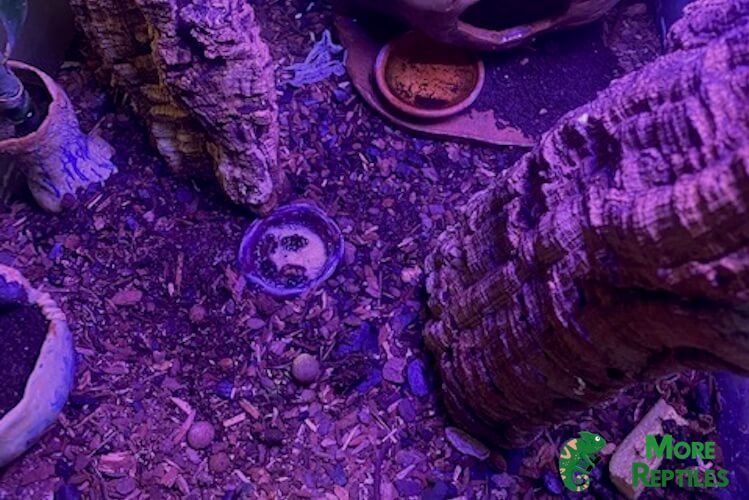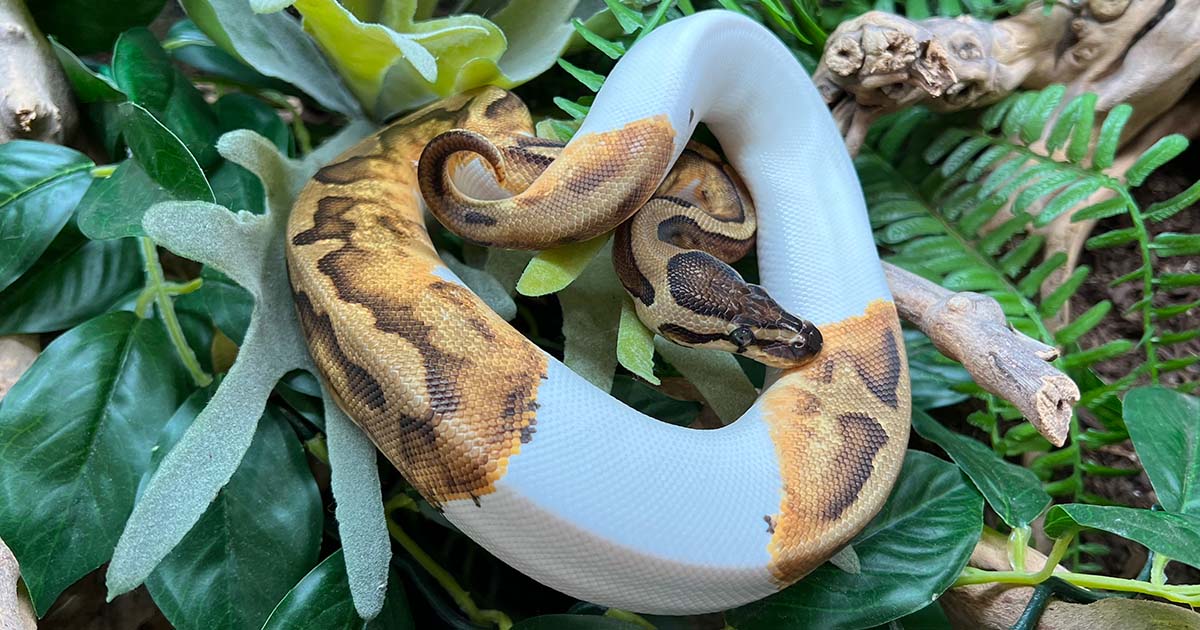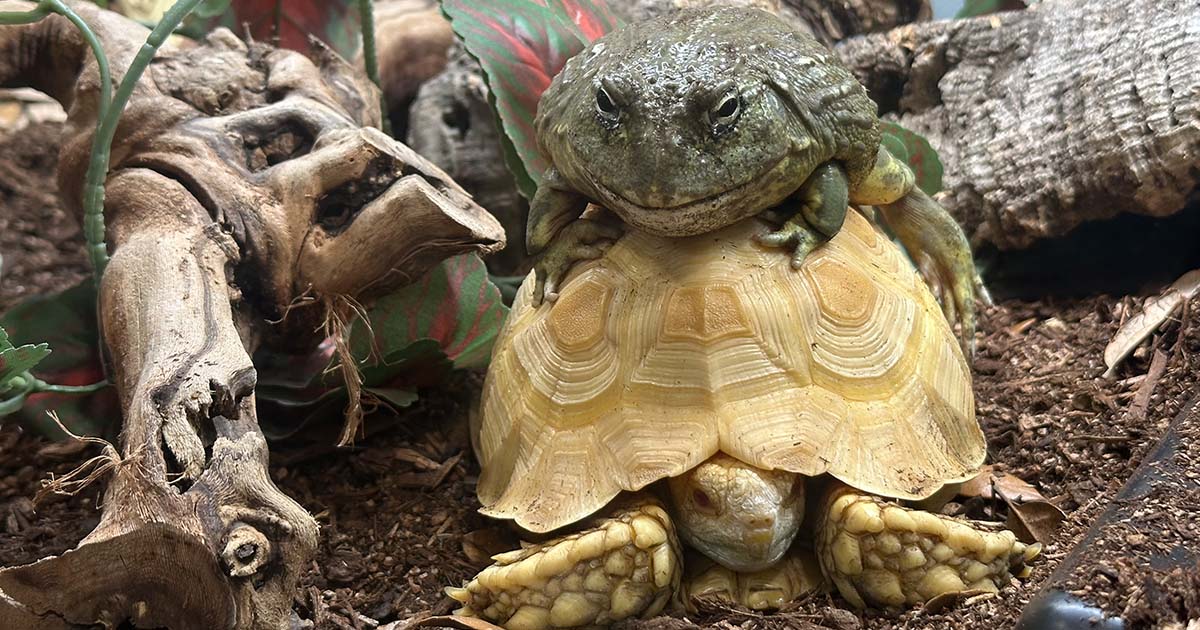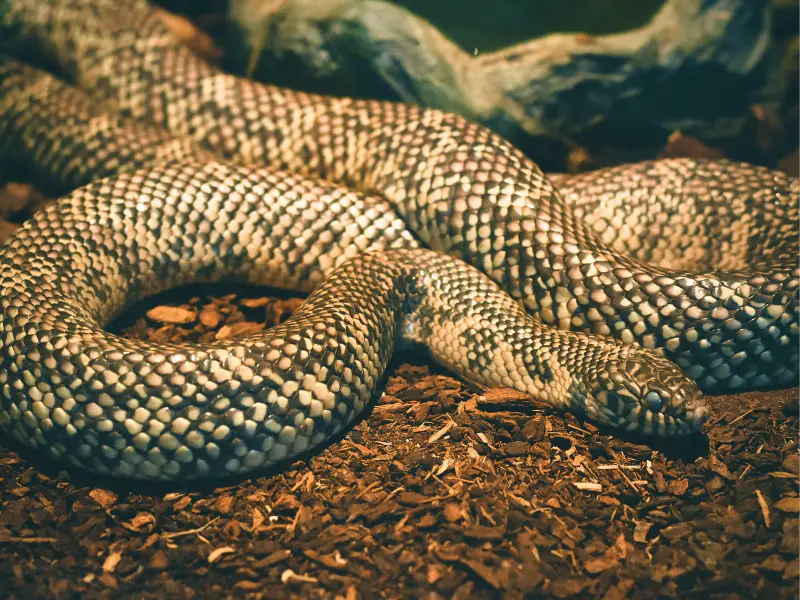Anything placed at the bottom of a Crested Gecko’s enclosure is called “substrate”.
For beginners, deciding on what should go at the bottom of the tank is not an easy task! There are a variety of choices from a bare bottom to a fully planted tank. There is also a keen debate about which substrate for Crested Geckos is best.
I was spared some of this as I decided that I wanted a planted tank. Based on my experience with other geckos, a bare bottom can be ugly and hard to clean. At the time that I set up my first planted enclosure, coco fiber was the only choice for a planted tank.
There are now many Crested Gecko substrates, but not all are equal. Your decision should consider humidity control, safety and enclosure setup.
Key Takeaways
- Crested Gecko substrate can be particulate (pieces of material) or non-particulate (solid sheet).
- Particulate substrate is very useful for female Crested Geckos who are laying eggs.
- Non-particle substrate is less effective in holding humidity.
- Substrates such as paper towels or newspapers should be changed when they become noticeably dirty or torn.
- The substrate in a truly bioactive enclosure doesn’t need to be changed.
- Substrate safety for a Crested Gecko that spends most of its time in the upper part of the enclosure is not as crucial as for ground-dwelling species.
Crested Gecko Substrate 101

Substrate for a Crested Gecko can be particulate (e.g. coco fiber, sphagnum moss, leaf litter and ABG mix) or non-particulate (e.g. ceramic tiles, slate, shelf liner, vinyl tiles, newspaper and paper towels).
First and foremost, a substrate needs to be safe.
This rules out materials that contain chemicals known to be toxic to reptiles such as cedar. It also rules out any wood product that includes sap or other sticky or gooey substances.
Since a substrate usually contains ground up plant matter, any plant which causes skin irritation or has an odor that causes respiratory problems should be avoided. A list of poisonous plants to reptiles can be found here.
Another safety concern is impaction.
Impaction in Crested Geckos happens when their digestive tract is blocked by a solid substance.
I once cared for a gecko that had dropped her tail after eating some pieces of walnut bark substrate. The bark passing through her digestive tract caused enough pain and distress for this to happen.
Some keepers worry about possible impaction to the point where they choose a non-particulate substrate. While a Crested Gecko may occasionally eat the substrate by accident during hunting, it is uncommon for them to have difficulty passing soil-like substrates such as coco fiber.
Crested Geckos generally explore their environment by licking it, not by eating it substrate
Substrates that could genuinely cause impaction are also unsafe. This includes calcium sand (not usually a choice for an arboreal rainforest species), small wood chips (that are easily swallowed), and seeds or pellets.
The next consideration is personal taste; of the keeper, not the gecko!
Some keepers value a more naturalistic setting. Others may want a more “modernistic”, clean tank in which case they will choose ceramic tile or slate.
When I considered getting my first Crested Gecko 16 years ago, I wanted to create a “jungle”. This allowed me to experiment with plants and provide lots of hiding places for my gecko.
Finally, some keepers prioritize cost and ease of cleaning and maintenance.
While no substrate is hugely expensive, paper towel and newspaper is nearly free and disposable. It also doesn’t need to be cleaned.
A bioactive environment is more expensive and time consuming to set up, but will also maintain itself. Soil-like substrate is probably the most expensive and could run up to $30 for a larger enclosure.
| Type of Substrate | Pros | Cons |
|---|---|---|
| Atlanta Botanical Gardens Mix | Holds moisture and humidity well Good for plants Appropriate for bioactive or non-bioactive enclosure |
Most expensive option (could be as much as $30) |
| Coco Fiber | Holds moisture reasonably well Adequate for plants |
May require installing a drainage layer |
| Cypress Mulch | Good for holding moisture and humidity | Particles are large Looks more like “wood” than “soil” |
| Ceramic Tile | Cheap and easy to clean | Doesn’t look like a natural environment |
| Shelf Paper | More durable than paper towels Cheap and easy to replace when it gets dirty |
Doesn’t look natural Enclosure decor and furniture will need to be removed when the paper is replaced |
Non-Bioactive
Some new keepers may feel overwhelmed by the details of setting up their first gecko enclosure. If you are still not sure, check out our guide on Crested Gecko temperatures and humidity range.
For these keepers, it is easier and less stressful to provide a basic substrate and to “see how it goes”.
Although I never considered a non-bioactive substrate for my first Crested Gecko enclosure, here are my top five choices:
- ABG Substrate Mix
- Cypress Mulch
- Ceramic Tile
- Coco Fiber Brick
- Shelf Paper
ABG Substrate Mix

“ABG” stands for “Atlanta Botanical Gardens”, one of the first places to sell this Crested Gecko substrate.
The mix, whose ingredients vary from brand to brand, contains ground plant parts such as coco fiber, peat moss, sphagnum moss, orchid bark as well as small amounts of charcoal.
This mix produces a substrate that doesn’t leave a muddy residue like dirt and is less dense than dirt. This results in better aeration and humidity control. The particles are also small enough to pass through a Crested Gecko’s digestive system if it happens to eat some.
These substrate mixes look natural like soil, but contain no “dirt”.
ABG Substrate is my top choice for substrate in a Crested Gecko environment.
If the keeper decides to switch to a bioactive setup later, the substrate is already in place. The only real difference between a bioactive and non-bioactive enclosure, once this type of substrate is in place, is the presence of plants and a “cleanup crew” of little bugs.
Even without the official “bioactive” label, often the geckos’ droppings will break down and become part of the substrate anyway, which is an important part of a bioactive setup.
Another advantage I’ve found is that it only needs to be “changed” less than once a year, although the instructions on the package suggest that the substrate needs to be changed every few months.
The biggest disadvantage of this substrate is that it’s more expensive than most others.
You can expect it to cost about $10-$30 depending on the size of the enclosure.
An additional cost would be the installation of a drainage layer (hydroton balls and a layer of vinyl mesh) to keep the substrate from getting waterlogged. It is questionable whether this is even necessary though, given the substrate already holds moisture well.
Cypress Mulch
Cypress mulch is made from ground or shredded cypress bark.
Its primary benefit is that it retains moisture well and iso makes it much easier to control humidity levels.
Cypress mulch is often used as a mulch for gardens. To ensure that no unsafe products have been added, it is recommended you only buy one designed for reptile enclosures. Try to avoid buying it from your local garden center.
When used with other soil-like substrates (e.g. ABG), it provides a great texture variety and helps with water retention and humidity.
Ceramic Tile

Ceramic tiles are an excellent choice for those keepers who like a “modern” look. They are also cheap, easy to clean and attractive.
Although I don’t use ceramic tiles for Crested Gecko enclosures, it is my top choice for Leopard Gecko substrate. Since Leopard Geckos spend most of their time on the substrate and require lower humidity, it works very well for them.
I choose not to use it for Crested Geckos because I prefer a more “natural” look and it makes daily misting difficult.
Ceramic tile can be purchased from the flooring department of any home improvement store. Tiles vary quite a bit in price, but I usually choose the cheapest, which are less than $2 for a 12×12” tile.
I find the textured beige tiles to be best suited for reptile enclosures.
Tile can be cut to size for a relatively small fee, it is not likely that you will find a tile that fits the footprint of the enclosure exactly.
Home improvement stores also sell tiles made of other materials, including slate.
These tiles can be used as well and share the same advantages of being cheap, easy to clean and attractive, although they are heavier and harder to cut.
Coco Fiber Brick
Coco fiber, also called “eco earth” or “coco coir”, is a substrate made from ground coconut shells. It is similar to the ABG mix described above, but doesn’t contain all the ingredients of the mix (e.g. peat moss, sphagnum moss and orchid bark).
This substrate is sometimes sold in a bag, where it looks like potting soil.
It is more commonly sold in a compressed brick, where it gets its name from. This is a hard, dense, brick-sized chunk and is readily available from large chain pet stores. It is turned into a more soil-like substance by placing it in a large bowl and adding water to rehydrate it.
Coco fiber may not be as light and airy as ABG mixes, but it works nearly as well. It also has the benefit that it can also be converted to bioactive.
Shelf Paper
Shelf paper is my top choice for a substrate that is cheap and disposable. Of all the possible choices (including paper towel and newspaper), shelf paper will stand up best to the daily misting. It can also be spot-cleaned quickly and easily.
This substrate is sold in home improvement and hardware stores and comes in a variety of designs and patterns. If the keeper gets bored with the design, it is easy to purchase another roll of shelf paper with a different design.
A single 20ft roll of shelf paper is long enough for multiple sheets of the proper size.
Each piece that’s cut off the roll would probably need to be changed monthly. Eventually it will become ragged looking and can then be swapped out for another piece of shelf paper.
Author Tip: Shelf paper comes in rolls, so initially the piece that’s cut for the enclosure may curl up. This can be fixed by placing rocks or decor at each corner.
Bioactive

In my opinion, a bioactive enclosure is the way to go to for Crested Geckos.
The idea behind a bioactive substrate setup is that it allows a natural cycle of waste management, oxygen and carbon dioxide exchange.
Since a bioactive enclosure is self-renewing, it doesn’t need to have regular substrate changes. In fact, cleaning would break up the cycle. It is also very cool to have a mini biosphere in your own home!
The only real difference between a bioactive and non-bioactive enclosure, is the presence of plants and a “cleanup crew” of little bugs. The biosphere is maintained by the interaction between the gecko, the plants and the bugs which eat droppings and the dead leaves from the plants.
Here are my top three choices for Crested Gecko bioactive substrates:
- Coco Fiber
- ABG Mix
- DIY Mix
Coco Fiber

Coco fiber is made from ground coconut shells.
I use Coco Fiber for some of my bioactive enclosures because it is much cheaper than ABG mixes. From experience it is also very good for holding moisture and I have not had to change or clean my coco fiber substrate in any of my bioactive tanks.
The best bet, when using coco fiber, is to install a drainage layer of about 2” of hydroton expanded clay balls overlaid with a piece of vinyl mesh cut to the size of the enclosure floor (pictured above).
You can easily find coco fiber bricks from large chain pet stores and hydroton expanded clay balls from from reptile supply stores or hydroponic stores.
In general, I have my coco fiber substrate 2-4” deep. This is deep enough for plants to root if you plan to plant directly into the substrate.
Care should be taken that the substrate, along with the drainage layer, don’t rise so high that they will spill out of the door when it is opened. In my Exo-terra enclosure, the bottom of the door is 7” from the bottom of the cage.
ABG Mix

ABG is a great choice for a bioactive Crested Gecko substrate.
All ABG mixes have a combination of ground-up plant parts such as coco fiber, peat moss, sphagnum moss, orchid bark as well as small amounts of charcoal. The result is a mix that holds moisture well, is light and airy and can support plants as well as the “cleanup crew” (bugs such as isopods and springtails) required for a truly bioactive setup.
I have used this mix in a number of my newer Crested and Gargoyle Gecko environments successfully, without the drainage layer and with no buildup of water at the bottom.
Although the instructions on the package suggest that this substrate needs to be changed every few months, in reality I have found that with bioactive enclosures, it doesn’t need to be changed at all. Some of my enclosures have been going for more than 10 years!
Substrate mixes are a bit more expensive than other bioactive substrates and can cost close to $30 for 10 quarts.
DIY Mix
Some keepers choose to mix their own bioactive substrate because it is often cheaper than purchasing a packaged mix.
The primary ingredient to use should be coco fiber since it is sold in the correct consistency, and is easy and cheap to buy. Add to this small amounts of play sand, sphagnum moss, peat moss and leaf litter.
Leaf litter includes dead leaves and twigs that fall to the ground outdoors wherever there are trees or plants. It is crucial to be sure that the leaf litter hasn’t been in contact with pesticides. The safest places are likely your own backyard. If using untreated leaf litter provokes too much anxiety, either don’t use it or bake it for 15 minutes at 400F.
I haven’t felt the need to make my own substrate, since there are so many good mixes in the market at reasonable prices.
Common Mistakes

Many first time keepers of Bearded Dragons and Crested Geckos pick sand as a substrate! Don’t do this.
I don’t know why anyone would choose sand as a substrate for Crested Geckos since they do not live in a desert environment! Calcium sand has been known to cause digestive distress in terrestrial geckos who eat it. It is really best to avoid sand altogether.
Here are a few other substrates and reasons why not to use them for Crested Geckos…
- Sand
- Reptile carpet
- Recycled paper
- Alfalfa pellets or millet seeds
Reptile carpet is often used for Leopard Geckos. It is made from fibers that are processed to form a felt-like material. The problem with reptile carpet is that the continual moisture from misting can easily result in mold, mildew and a bad-smelling environment.
Recycled paper bedding is shredded recycled paper which forms a fluffy bedding. While it may be a good choice for snakes, the daily misting will cause this paper to compact into paper maché! It will soon become a soggy mess that will then turn into a hard ball of paper.
Alfalfa pellets or millet seeds are frequently used for small mammals such as rabbits or guinea pigs. With daily misting, the millet seeds will likely sprout and then rot and the alfalfa particles will turn into a mushy sludge. In addition the pieces are easy for a Crested Gecko to swallow and will most likely be difficult to digest and pass.
Fortunately, there are many great substrates for both bioactive and non-bioactive enclosures that are safe and attractive.



